On 3 Jan. 2019 the
whole world watched how
a Chinese spacecraft landed on the far side of the moon.
“This is a great
technological accomplishment as it was out of sight of Earth, so signals are
relayed back by their orbiter, and most of the landing was actually done
autonomously in difficult terrain,” said Prof Andrew Coates, a space scientist
at UCL’s Mullard Space Science Laboratory. “The landing was almost vertical
because of the surrounding hills.”

Chang’e-4’s landing
site in Von Kármán crater, though, is on the far side of the Moon, where the
spacecraft can no more easily be reached by radio than it can be seen through a
telescope. Landing there and getting data back afterward is possible only with
the help of a cunningly pre-positioned relay satellite. Other countries have
considered such missions, but none has ever mounted one. China has been
carefully building up the capacity to go where they have not; now it has done
so.
China is keen on such
signals of pre-eminence and willing to put in the work they require. It wants the world, and its own people, to know that it
is a global power--that it boasts not just a titanic economy, but the
geopolitical sway and military might to match, soft power of all sorts, a
storied past and a glorious future. Science is a big part of this. It is seen
in China, as elsewhere, as an ennobling pursuit and a necessary foundation for
technological advance. China’s leaders see such advances as crucial not just to
their economy, but also to expanded military prowess and social progress. They
want the sort of science that will help China project its power and respond to
its people’s particular problems. They want new clean-energy sources and
freedom from resource constraints. And the country’s ever greater scientific
proficiency makes such ambitions look realizable. It is a long way from landing
on the Moon to mining it. But it is not uncommon to hear speculation about such
things.
Earlier in August
2018 Trym Eiterjord writing for the Diplomat,
remarked about the looming challenge for science in China: that
the restoration of Mr. Science would likely necessitate a greater space for his
companion, Mr. Democracy. After the fall of the Qing dynasty, in the first
decades of the new republic, Chinese intellectuals were mapping the possible
pathways of a Chinese modernity. This period, culminating
in the May Fourth Movement in 1919, saw a myriad of different political
programs spar against each other. One overarching concern was the relationship
between democracy and science--or rather, a discussion of whether a wholesale
importation of European Enlightenment values was necessary for ensuring China’s
own modernity. Taken as two fundamental elements of modernity, science and
democracy became personified as Mr. Science and Mr. Democracy in the writings
of Chen Duxiu, one of the founders of the Chinese Communist Party. Mr.
Democracy and Mr. Science, it was thought, would replace old Confucian modes of
organization, jettison traditional epistemologies, and promptly help usher in a
truly modern China. For Chen, China’s political, intellectual, and moral
ailments could all be cured by a comprehensive adoption of scientific and
democratic values. In the magazine New Youth, Chen asked the reader to consider
the “many upheavals” that had occurred in the West “in support of Mr. Democracy
and Mr. Science, before these two gentlemen gradually led Westerners out of
darkness” and argued that only these two forces could “resuscitate China.”
Xi’s determination
There is no doubting
President Xi Jinping ‘s determination. Modern science depends on money,
institutions and oodles of brainpower. Partly because its government can
marshal all three, China is hurtling up the rankings of scientific achievement.
As the investigation
below shows, China has spent many billions of dollars on machines to detect
dark matter and neutrinos and on institutes galore that delve into everything
from genomics and quantum communications to renewable energy and advanced materials.
An analysis of 17.2m papers in 2013-18, by Nikkei, a Japanese publisher, and
Elsevier, a scientific publisher, found that more came from China than from any
other country in 23 of the 30 busiest fields, such as sodium-ion batteries and
neuron-activation analysis. The quality of American research has remained
higher, but China has been catching up, accounting for 11% of the most
influential papers in 2014-16.
Such is the pressure
on Chinese scientists to make breakthroughs that some put ends before means.
Last year He Jiankui, an academic from Shenzhen, edited the genomes of embryos
without proper regard for their post-partum welfare—or that of any children they
might go on to have. Chinese artificial-intelligence (AI) researchers are
thought to train their algorithms on data harvested from Chinese citizens with
little oversight. In 2007 China tested a space-weapon on one of its weather
satellites, littering orbits with lethal space debris. Intellectual-property
theft is rampant.
But Chinese science
is about much more than weapons and oppression. From better batteries and new
treatments for disease to fundamental discoveries about, say, dark matter, the
world has much to gain from China’s efforts.
Moreover, it is
unclear whether Xi is right. If Chinese research really is to lead the field,
then science may end up changing China in ways he is not expecting.
Money counts also
The huge hopes China
has for science have prompted huge expenditure. Chinese spending on R&D
grew tenfold between 2000 and 2016. This open checkbook has bought a lot of
glitzy kit. Somewhere in the Haidian district of
Beijing, which houses the Ministry of Science and Technology as well as
Tsinghua and Peking Universities, it seems there is a civil servant quietly
ticking things off a list of scientific status symbols. Human space flight?
Tick. Vast genome-sequencing facilities? Tick. Fleet of research vessels? Tick.
World’s largest radio telescope? Tick. Climate researchers drilling cores deep
into the Antarctic ice cap? Tick. World’s most powerful supercomputer? Tick
(erased when America regained its lead, but watch this space). Underground
neutrino and dark-matter detectors? Tick and tick. World’s largest particle
accelerator? The pencil is
hovering.
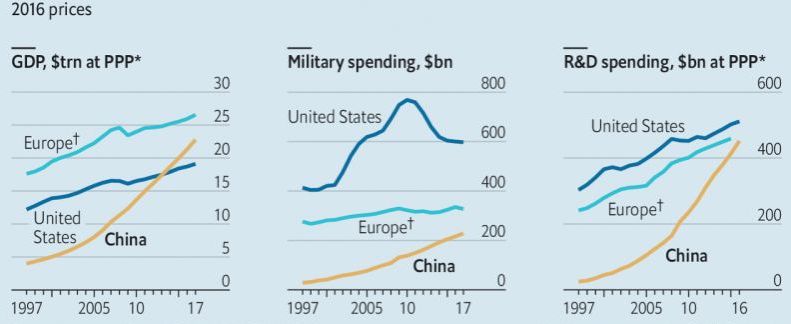
The spree is
tellingly reminiscent of the golden years of “big science” in post-war America.
Between the International Geophysical Year of 1957 and the cancellation of the
Superconducting Super Collider (SSC) in 1993, America’s government unfailingly
invested ever more of the resources of an ever more powerful economy into the
things which the leaders of its scientific community most wanted. From the
creation of quarks to the cloning of genes to the netting of Nobel prizes,
American science came to dominate the world.
Over those 40 years
America—and, to a lesser extent, Europe—were doing things that had never been
done before. They opened up whole new fields of knowledge such as high-energy
astrophysics and molecular biology. Benefiting from the biggest and best-educated
native generations ever produced, they also welcomed in the brightest from
around the world. And they did so in a culture dedicated to free inquiry, one
keenly differentiated from the communist culture of the Soviet bloc.
Measured against that
boom—one of the most impressive periods of scientific achievement in human
history—China’s new hardware, grand as it often is, falls a bit short. It has
been catching up, not forging ahead. It has not been a beacon for scientists elsewhere.
And far from benefiting from a culture of free inquiry, Chinese science takes
place under the beady eye of a Communist Party and government which wants the
fruits of science but are not always comfortable about the untrammelled
flow of information and the spirit of doubt and critical scepticism
from which they normally grow.
America’s science
boom had a firm institutional and ideological foundation. It grew out of the
great research universities that came into their own in the first half of the
20th century, and whose intellectual freedom had attracted
extraordinary talents threatened by regimes elsewhere, including Albert
Einstein, Enrico Fermi and indeed Theodore von Kármán, the Hungarian-born
aeronautical engineer in whose honour Chang’e-4’s new
home is named. China has imported ideas and approaches more than people and
ideals. The resultant set-up has the ricketiness often seen in structures
ordained from the top down rather than built from the bottom up.
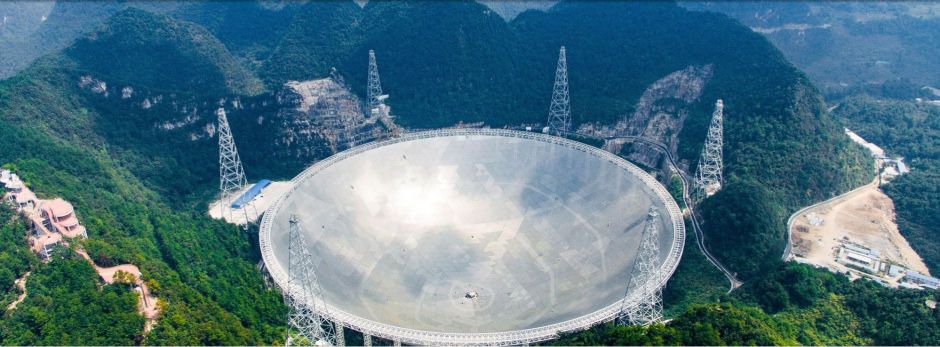
Top-down ambition can
mean running before you walk. Take FAST, the Five-hundred-metre
Aperture Spherical Telescope, which opened in 2016. Built in a natural basin in
Guizhou province, it is more than twice
the size of the world’s next-largest radio telescope, in America. But FAST
does not have a director. Having leaped from nowhere to the top of the tree in
terms of hardware, the country finds itself in the embarrassing position of
having no radio-astronomer to hand who combines the scientific and administrative
skills needed to run the thing.
Self-defeating
shortcuts, symbolic and otherwise, are not only the preserve of the government;
Chinese scientists are prey to such temptations, too. China is not only
recapitulating American science’s cold-war national-prestige boom. It is doing
so in the context of the subsequent high-technology era in which no American
university feels complete without a symbiotic microbiome of venture capitalists
pullulating across its skin. The economic benefits of research have
increasingly come to be seen as a possible boon to the researcher, as well as
to society at large.
For a particularly
egregious example, consider the most notable Chinese scientific first of 2018.
He Jiankui looked like the model of a modern Chinese scientist. He was educated
at the University of Science and Technology of China (USTC) in Hefei. He went
on to equally prestigious American universities, Rice and Stanford. He was
brought back by the government’s “Thousand Talents” programme
to a new position at the Southern University of Science and Technology in
Shenzhen. Once established there, he took unpaid leave to start an
entrepreneurial project.
That project was
editing the DNA of embryos that would then grow up into human beings. Its
result was two baby girls. They do not, as yet, appear unhealthy. Nor, though,
have they been provided with the questionable advantages Dr He Jiankui says he was trying to provide through his
tinkering—tinkering which was unsanctioned, illegal and which, since he went
public, has seen opprobrium heaped upon him.Since
then Shenzhen authorities have tightened
the ethical review process for biomedical research involving humans with its
own set of local regulations.
You can’t clone success
The He affair could have
taken place in many places, and it is hardly representative of the broad swathe
of China’s researchers; 122 of them signed an open letter denouncing his
actions. At the same time, it is not at all surprising that the He affair took
place in China. It was a perversion of what Chinese scientists are trying to
achieve as they seek to establish themselves and their country in the world of
elite science. But it was also an illustration of it.
The staggering growth
in the number of scientific papers by Chinese researchers needs to be seen in
this context. In terms of pure numbers, China overtook America in 2016 (see
chart 2). But the quality of some of these papers is very low. In April 2018 Han
Xueying and Richard Appelbaum of the University of
California, Santa Barbara, reported opinions gathered in a survey of 731
researchers at top-tier Chinese universities. As one from Fudan University put
it: “People fabricate or plagiarise papers so that they
can pass their annual performance evaluations.”
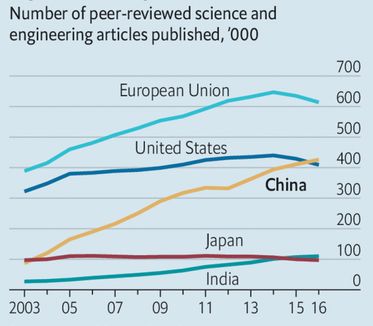
The Chinese
government is aware of the risks of a reputation for poor and even fraudulent
research. It is one of the reasons that it is orchestrating the development of
a scientific establishment. One of its pillars is a core group of elite
universities known as the C9. Fudan is one of them, as are Tsinghua and Peking
Universities and Dr He’s alma mater, USTC. The other is the Chinese Academy of
Sciences (CAS), an official agency that runs laboratories of its own, which
will adhere to prevailing international standards. The government is clamping
down on shoddy journals, especially those in which researchers pay to be
published. Raising standards in this way will not just improve science; it will
also attract the best scientists.
After Deng Xiaoping
came to power in 1978 the top tier of Chinese students was encouraged to go
abroad for their graduate studies. Many returned, as had been intended, filled
with knowledge unavailable at home. Without them the current scientific boom would
not have happened, however much the government had spent. But the best often
chose to stay abroad. In 2008 the country started the Thousand Talents programme to draw these exiles back with promises of lucre
and lab space.
In theory, the programme is open to any top-notch researcher working in an
overseas laboratory, regardless of nationality. In practice, few non-Chinese have availed themselves of it. But many Chinese
have. Such returners are known as haigui, the Chinese
for “sea turtle”, since they are thought of as having come back to their natal
beach, as turtles do, to lay their eggs.
Talent that has not
been abroad is not, however, neglected. A coeval programme,
Changjiang Scholars, is aimed at identifying potential top-flight researchers
who are languishing in thousands of provincial institutions. Once identified,
they, too, are brought into the charmed circle.
Ventures into relativly new
fields
This is yielding
results at all but the very highest levels. Chinese scientists working in China
have as yet earned only one Nobel prize. Other than that work, the discovery of
artemisinin, a novel antimalarial drug, by Tu Youyou,
there has not yet been any Chinese scientific advance that a fair-minded person
would be likely to think Nobel-worthy. No fundamental particle has been
discovered there, nor any new class of astronomical object. Chinese scientists
have not yet done anything to compare with, say, the development of CRISPR-Cas9
gene editing (America) or the creation of pluripotent stem cells (Japan) or the
invention of DNA sequencing itself (Britain).
But a great deal of
Chinese science is now very good indeed, particularly in relatively new fields
with practical implications. The country has a very large and ever growing
workforce (see chart 3) that is both enjoined and keen to tackle juicy topics.
A study published by Elsevier, a scientific publisher, and Nikkei, a Japanese
news business, on January 6th found that China published more
high-impact research papers than America did in 23 out of 30 hot research fields
with clear technological applications. Chinese science is a nimble giant,
capable of piling in on any new field of promise with enormous, often centrally
encouraged, force.
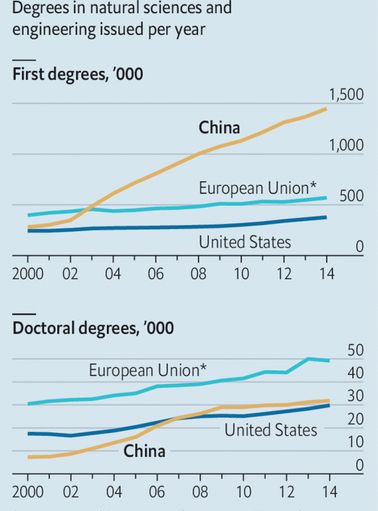
Developments in fields
such as double-layer capacitors and biochar, two of those 23, may be important
but are unlikely to be much noticed, either by Nobel committees, the public or
foreigners who need impressing. For visible signals of its national prowess,
China is following the well-trodden path of big science in America, Europe, and
Japan: building large physics experiments and putting things—especially
people—into space.
The China National
Space Administration has sent several “taikonauts” into orbit and provided them
with some small space labs to hang around in while they are there. Its plans
include, in the near term, a bigger space station, assembled in orbit from modules
launched separately, and in the longer, term crewed missions to the Moon
enabled by a new booster more powerful than any of today’s, the Long March 9.
The National Space
Science Centre, part of CAS, is busy putting up scientific satellites; in April
2018 it announced six new ones that should be launched by 2020 or soon after.
Most of China’s launches, though, are not scientific; they are for communications,
Earth observation—and military intelligence. China’s space programme
began in the bosom of the People’s Liberation Army (PLA), and though it is no
longer directly run by the armed forces, they are still keenly involved with
the development of the country’s orbital abilities. In 2007 China tested an
anti-satellite weapon; its “Strategic Support Force” is thought to coordinate
its military space-, electronic- and cyber-warfare capabilities. All China’s
taikonauts are PLA officers. Other physics facilities have obvious military
applications, too, such as wind tunnels designed for research into forms of
hypersonic flight that are really relevant only to the armed forces.
Beyond rocketry,
China’s most ambitious big-science plan is to build the largest particle
accelerator ever. Since their development in the 1930s, circular particle
accelerators have grown from the size of a room to the size of the Large Hadron
Collider (LHC), which occupies a 27km loop of tunnel beneath the Franco-Swiss
border at CERN, Europe’s particle-physics laboratory. The bigger the
accelerator, the more energy it can pump into its particles. The LHc packs its protons with more than a million times more
energy than the original machines did in 1930s Berkeley.
Sharpening the gene shears
The Chinese plan
foresees a loop of tunnel as much as 100km long. Even China will not be able to
foot the bill for such a beast alone. In the 2000s the LHC cost CERN over
SFr4bn ($5bn); contributions to its experiments from other countries, including
China and America, significantly increased the total. Making use of it has cost
billions more. Nor would China be able to supply all the physicists needed to
make use of such a facility. Like the LHC, the next accelerator will be a
single lab for the world, wherever it is: these toys are one-per-planet
affairs. But the Chinese seem more serious than anyone else about hosting and
building the thing. Just as it meant something beyond the world of particle
physics when America canceled its proposed giant SSC and CERN’s LHC became the
biggest game in town, so it would mean something if China took CERN’s crown.
Particle physics
enjoys a particular prestige in part because of its early (and now dissolved)
association with the development of nuclear weapons, in part because of the
conceptual depths it plumbs, in part because of the sheer size and expense of
its tools. But there are other parts of physics with more of the cutting edge
about them. These include applications of the more abstruse aspects of quantum
mechanics to computation and cryptography, an area where China is a world
leader: it was the first country to send a quantum-encrypted message via a
satellite. In computer science, too, it has few peers. Though it does not yet
have a semiconductor industry that quite matches those elsewhere, it is world
class in many applications, especially in artificial intelligence.
The same applies in
trendy bits of biology. The above mentioned Dr He was not the first person to
edit the DNA of a human embryo. That honour belongs
to Huang Junjiu, a researcher at Sun Yat-sen
University, in Guangzhou, whose research was blameless and above-board. Like Dr
He, Dr Huang was making use of the capabilities of CRISPR-Cas9. Since 2012 this
form of gene editing has become one of the hottest fields in biology, and China
is very well represented in it (see chart 4); according to the study by Elsevier
and Nikkei, it is publishing 22.6% of the world’s most highly cited papers in
gene editing, slightly more than half the amount that comes from America, and
far more than from any other country.

Dr
Huang wants to apply CRISPR-Cas9 to the treatment of beta thalassemia, a
hereditary blood disease. To this end, in 2015 he successfully edited the DNA
of several fertilized human eggs left over from IVF treatment. He had no
intention of implanting the results in anybody’s womb; he used embryos which,
due to other abnormalities, were not able to develop. What he learned about
gene editing in those experiments will, if all goes well, be used to edit
stem-cells extracted from the bone marrow of people suffering from the disease,
allowing them to make better red blood cells.
Stem-cell research is
another hot topic to which China is adding its heft. Zuo Wei of Tongji
University in Shanghai is trying to
use stem cells to repair lungs damaged by emphysema, a big problem in
China, where smoking is still common and the air often dense with smog. Last
year he conducted a trial in which four patients had some lung tissue removed.
The most healthy-looking stem cells in that tissue were isolated and encouraged
to multiply, and the revved-up results then sprayed back into the lung. The
procedure apparently repaired the lungs of two of the patients; the other two
showed neither benefits nor harm. Dr Zuo has since organized a second trial of
100 patients. He is working on a similar approach to kidney disease, but so far
only in mice.
Let 100,000 genomes bloom
Dr Zuo’s work
demonstrates another feature of Chinese bioscience: keeping its application
clearly in mind. In the West, there has been an increasing concern over the
past couple of decades that basic biology led by independent academic
researchers has drifted too far from the potential medical application. In
America, in particular, biomedical-research prowess and the health of the
population are increasingly poorly correlated.
This concern has led to
a new emphasis on building up “translational-medicine” research capacities to
bridge the gap—an idea the Chinese are already integrating into their work. The
government has opened a translational-medicine center in Shanghai, where
laboratory researchers, clinicians, and patients will all be under the same
roof and biotech companies encouraged to set up shop next door. Others may
follow in Beijing, Chengdu, and Xi’an.
Genetic research is a
field where China has both made big investments and sees a big future. In the
BGI, as what was once the Beijing Genomics Institute is now known, China has by some
measures the largest genome-sequencing center in the world. Once an arm of
CAS, it declared independence as a “citizen-managed, non-profit research
institution” and has now become a semi-commercial chimera, with one of its
divisions listed as a company on the Shenzhen stock exchange.
The BGI’s corporate
arm is also taking an interest in beta-thalassemia; it has developed a DNA
blood test for it, one of an increasing range it is making available across
China. The tests use DNA-sequencing machines the BGI developed with technology
which it acquired when it bought Complete Genomics, an American firm, in 2013.
That battalion of
machines has a lot of other work to do. Non-commercial bits of the BGI use them
for pure research. The outfit is also home to the China National GeneBank, the intended repository for several hundred
million samples taken from living creatures of all sorts, human and non-human.
It already holds the genomes of 140,000 Chinese people, part of a wider desire
by the government to be at the forefront of the field of precision medicine, in
which diagnoses, and eventually treatments, are personalized with particular
emphasis on understanding a patient’s genetic make-up.
The BGI is one
example of China’s ability to bring big-science approaches to new areas of
research. For another, you should look inside a low building in Zhuanghe, Liaoning province, where the world’s largest
battery is taking shape. It is to have six times the storage capacity of the
system supplied by Elon Musk, an American entrepreneur, to South Australia in
2017, which lashed together thousands of lithium-ion battery cells to make the
world’s then-largest battery. It can do so because it uses a completely
different approach based on a flow of vanadium-salt solutions.
China’s
near-insatiable demand for energy has led to investments in wind and solar
power that dwarf those in other parts of the world and is now leading to
research into better ways of handling the energy they produce. Vanadium-flow
batteries are of interest because, unlike most batteries, in which a single
electrolyte is built into the cell, a flow battery has two electrolytes and an
open cell through which they pass. This means its storage capacity is governed
solely by the size of the tanks that store the electrolytes. That makes it
possible, in theory, to build batteries big enough to store energy on a scale
useful to large grids. The theory has been developed by Zhang Huamin, a researcher at the Dalian Institute of Chemical
Physics, a local arm of CAS. The factory in Zhuanghe,
owned by Dalian Rongke Power, a local electricity
company, is trying to turn theory into practice. If it works, it could
revolutionize grid-scale electricity storage.
The Dalian
Institute’s researchers are also looking into perovskites, materials with
applications both in batteries and in solar cells. Their aim—also being pursued
elsewhere in China and abroad—is to apply perovskite solutions to everyday
solar cells so that the resultant layers will absorb wavelengths of light that
the normal cells cannot absorb. This could produce much more efficient solar
panels for the relatively little extra cost. To the extent that academic
publications are a good measure of technologies quite close to the market,
perovskites are an area where China has a substantial lead over America, with
41.4% of the highest impact publications, compared with 21.5% from America.
Taking things on trust
China’s energy
research also extends to areas that the rest of the world is avoiding. China is
building 13 new nuclear reactors to add to its fleet of 45; it has 43 more
planned. If they are all built China will
become the world’s biggest generator of nuclear electricity. Those reactors
are of similar design to the plants already in operation around the world. But
China is also exploring new reactor technologies--or rather, technologies
abandoned elsewhere. These include reactors in which the core is filled not
with fuel rods but with little ceramic pebbles--or, in the case of thorium
reactors, with molten metal.
The lack of progress
such reactors have enjoyed in the West reflects a lack of appetite for new
sorts of nuclear power much more than a lack of scientific plausibility. If
China’s appetite is sharp and its researchers imaginative, progress may come
swiftly. The development of mass-produced, compact, cheap and safe nuclear
reactors would be a Chinese first that a world in the throes of climate change
would have real cause to celelebrate--and start
importing.
That possibility,
though, brings to the fore a shadow over the future of Chinese science. Making
novel nuclear reactors extremely safe requires critical thinking and obstinate
truth-telling; so does convincing others that you have done so. A culture that
provides the results the boss wants, or does not investigate inconvenient
anomalies, or withholds data from nosy outsiders is not good enough.
Those requirements
are very like the norms that are seen as basic to doing good science in the
West. Testing hypotheses, finding the flaws in the work on which your teacher’s
reputation rests, questioning your own assumptions, following the data wherever
they lead, sharing data openly with your rivals-sorry-colleagues: this is how
science is meant to work, even if in real life the ideal can be a bit
tarnished. In some labs and institutions in China things doubtless do work that
way. But the authoritarian system in which they are embedded makes it hard for
Chinese science to speak truth to power, or escape challenges to its integrity.
This gnaws at the scientific body politic, and saps resources, both financial
and moral.
In their survey of
Chinese researchers Dr Han and Dr Appelbaum heard many complaints about
excessive government interference. A respondent from Sun Yat-sen University
told them “There
is still not enough academic freedom in higher education. If the central
government makes one statement, even if it is not fair, all of the universities
have to follow suit.”
In matters of
promotion, job interviews and grant-giving, the question of who you know seems
much more important in China than in the West (and even there, it is not
negligible). For the past decade the National Natural Science Foundation of
China (NNSFC), one of the country’s main funding bodies, has been running a
campaign against such misconduct. Wei Yang, until recently the NNSFC’s boss,
describes a situation in which, to stop interference from outside, the
composition of interview panels is kept secret until the last minute. Panellists are not told in advance who candidates are, and
both panellists and candidates have their mobile
phones confiscated in order to avoid anyone being nobbled--which used to happen
even while interviews were being conducted.
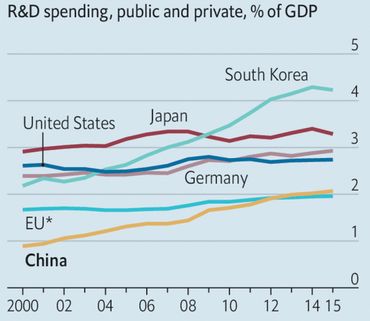
Some Chinese
scientists fear that the corruptions and silences endemic in authoritarian
states will hold them back from the breakthrough-making Nobel-winning heights.
Others may doubt this. China has been playing in science’s premier league for
only a decade or so. Its investments are not at an end. China’s R&D was
2.07% of GDP in 2015, up from 0.89% in 2000 (see chart 5). That is higher than
the average for European states, but lower than France, Germany or America. It
is much lower than in the Asian catch-up states that might be the most natural
comparators, Japan and South Korea. A China spending as much of its GDP on
research as South Korea does would have an R&D budget twice today’s. With
resources on that scale and a scientific workforce in the many millions, the
hobbling effect of corrupt institutions might be overcome by brute force.
Others might argue
that big breakthroughs are not the only measure of good science. Incremental
work that solves practical problems is not to be sniffed at. Scientific
research directed from the top down can serve national goals, and a one-party
system may give particularly consistent support to such programmes.
China’s lunar programme has built up its capabilities
steadily in a way no Western space-science programme
has since Apollo, the achievements of which it may yet match.
This is the sort of
methodical science that typically appeals to engineers oriented towards
results--and from Jiang Zemin onwards all China’s presidents, as well as almost
all its other leading politicians, have had engineering degrees. Xi Jinping,
today’s president, studied chemical engineering at Tsinghua.
But the idea that you
can get either truly reliable science or truly great science in a political
system that depends on a culture of unappealable authority is, as yet,
unproven. Perhaps you can. Perhaps you cannot. And perhaps, in trying to do so,
you will discover new ways of thinking as well as fruitful knowledge.
Will the restoration of Science also lead to a greater
space for Democracy?
Xi talks of science
and technology as a national project. However, in most scientific research
today, chauvinism is a handicap. Expertise, good ideas, and creativity do not
respect national frontiers. Research takes place in teams, which may involve
dozens of scientists. Published papers get you only so far: conferences and
face-to-face encounters are essential to grasp the subtleties of what everyone
else is up to. There is competition, to be sure; military and commercial
research must remain secret. But pure science thrives on collaboration and
exchange.
This gives Chinese
scientists an incentive to observe international rules--because that is what
will win its researcher's access to the best conferences, laboratories and
journals, and because unethical science diminishes China’s soft power. Dr He’s
gene-editing may well be remembered not just for his ethical breach, but also
for the furious condemnation he received from his Chinese colleagues and the
threat of punishment from the authorities. The satellite destruction in 2007
caused outrage in China. It has not been repeated.
The tantalizing
question is how this bears on Democracy. Nothing says the best scientists have
to believe in political freedom. And yet critical thinking, skepticism,
empiricism and frequent contact with foreign colleagues threaten
authoritarians, who survive by controlling what people say and think. Soviet
Russia sought to resolve that contradiction by giving its scientists privileges
but isolating many of them in closed cities.
China will not be
able to corral its rapidly growing scientific elite in that way. Although many
researchers will be satisfied with just their academic freedom, only a small
number need to seek broader self-expression to cause problems for the Communist
Party. Think of Andrei Sakharov, who developed the Russian hydrogen bomb, and
later became a chief Soviet dissident; or Fang Lizhi, an astrophysicist who
inspired the students leading the Tiananmen Square protests in 1989. When the
official version of reality was tired and stilted, both stood out as seekers of
the truth. That gave them immense moral authority.
Some in the West may
feel threatened by China’s advances in science and therefore aim to keep its
researchers at arm’s length. That would be wise for weapons science and
commercial research, where elaborate mechanisms to preserve secrecy already
exist and could be strengthened. But to extend an arms-length approach to
ordinary research would be self-defeating. Collaboration is the best way of
ensuring that Chinese science is responsible and transparent. It might even
foster the next Fang.
Hard as it is to imagine,
President Xi Jinping could end up facing a much tougher choice: to be content
with lagging behind, or to give his scientists the freedom they need and risk
the consequences. In that sense, he is running the biggest experiment of all.
For
updates click homepage here